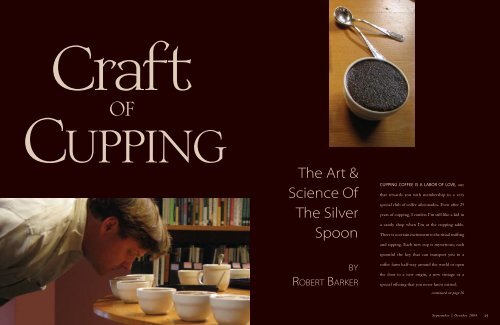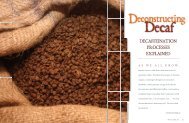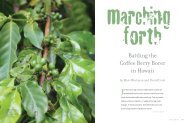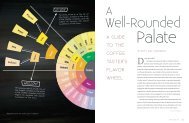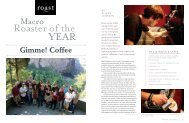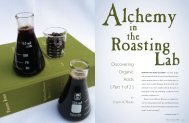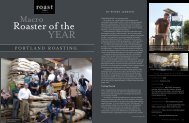Craft of Cupping - Roast Magazine
Craft of Cupping - Roast Magazine
Craft of Cupping - Roast Magazine
You also want an ePaper? Increase the reach of your titles
YUMPU automatically turns print PDFs into web optimized ePapers that Google loves.
<strong>Craft</strong><br />
<strong>of</strong><br />
<strong>Cupping</strong><br />
The Art &<br />
Science Of<br />
The Silver<br />
Spoon<br />
<strong>Cupping</strong> C<strong>of</strong>fee is a labor <strong>of</strong> love, one<br />
that rewards you with membership in a very<br />
special club <strong>of</strong> c<strong>of</strong>fee aficionados. Even after 25<br />
years <strong>of</strong> cupping, I confess I’m still like a kid in<br />
a candy shop when I’m at the cupping table.<br />
There is a certain excitement to the ritual sniffing<br />
and sipping. Each new cup is mysterious; each<br />
spoonful the key that can transport you to a<br />
c<strong>of</strong>fee farm half-way around the world or open<br />
the door to a new origin, a new vintage or a<br />
special <strong>of</strong>fering that you never knew existed.<br />
continued on page 26<br />
24 roast September | | October October 2004 2004 25 25<br />
by<br />
RobeRt baRkeR
CRAFT OF CUPPING ( continued)<br />
Unlike the majority <strong>of</strong> the food and beverage industry, where<br />
tasters in white coats are sequestered in sterile laboratories, c<strong>of</strong>fee<br />
cuppers seem to be a little more social.<br />
While taste assessment is essential for<br />
quality control and for determining a<br />
c<strong>of</strong>fee’s appeal, it is also an opportunity<br />
for cuppers to engage the public and<br />
share their enthusiasm.<br />
<strong>Cupping</strong> is a system <strong>of</strong> classification<br />
based on a few learned skills. Once you<br />
learn these skills and have a chance<br />
to practice and become confident in<br />
your abilities, you’ll find that cupping<br />
reveals the answers to many <strong>of</strong> the most<br />
important roasting questions.<br />
Whatever your cupping level is,<br />
a good vocabulary is paramount for<br />
communicating with green c<strong>of</strong>fee<br />
suppliers and for recording your<br />
impression <strong>of</strong> c<strong>of</strong>fees received. Novice<br />
cuppers are encouraged to invent their<br />
own terms when first introduced to<br />
the revolving table and silver spoon.<br />
Learning a vocabulary <strong>of</strong> a hundred<br />
or so terms is daunting at first glance.<br />
FRee INFO #129<br />
It’s more important to write your impression in your own words<br />
when starting out and gradually integrate the pr<strong>of</strong>essional terms as<br />
you become more accomplished. You can<br />
modify and add to your own list—it’s<br />
something you grow into. (To help<br />
you get started, check out the cupping<br />
glossary on page 36.)<br />
Why Cup?<br />
There are so many reasons to get<br />
out your silver spoon: sourcing new<br />
c<strong>of</strong>fees, trouble-shooting problems,<br />
developing new blends, comparing<br />
your products with the competition or<br />
educating your staff.<br />
But perhaps the most important<br />
reason for cupping is a business one:<br />
if you don’t cup, you’re disadvantaged<br />
by everyone else who does. <strong>Cupping</strong> is<br />
quality control. Without a doubt, it is<br />
the most valuable asset to maintaining<br />
and improving the quality <strong>of</strong> your<br />
product. As a proponent <strong>of</strong> specialty<br />
c<strong>of</strong>fee, it’s important to assess the<br />
quality <strong>of</strong> the green c<strong>of</strong>fee purchases and follow that up with an<br />
assessment <strong>of</strong> your production roast.<br />
Here are a few discoveries a roaster or green c<strong>of</strong>fee buyer can make<br />
at the cupping table:<br />
What does growing altitude have to do with<br />
cup quality? Differences in acidity will<br />
become obvious when you taste high- and<br />
low-grown c<strong>of</strong>fees from the same region.<br />
What decaffeination process yields the best<br />
taste? Here I recommend using as many<br />
samples from the same national origin as<br />
possible. You may not know the quality <strong>of</strong><br />
the unprocessed beans, but you should be all<br />
right if using reputable sources. Try samples<br />
from each <strong>of</strong> the decaffeination processes:<br />
Cup methylene chloride, also known as<br />
MC or KVW; ethyl acetate, also known as<br />
EA or natural; water-processed; and CO 2 -<br />
processed. Use regular unprocessed c<strong>of</strong>fee<br />
from the same origin for a control, and note<br />
any papery or cardboard taste in the decaf<br />
samples. Some processes weaken the overall<br />
flavor, and others add <strong>of</strong>f tastes.<br />
continued on page 28<br />
26 roast September | October 2004 27<br />
FRee INFO #132<br />
What is the difference in a washed c<strong>of</strong>fee and a traditional dryprocessed<br />
c<strong>of</strong>fee? Here you can compare washed and natural<br />
version <strong>of</strong> c<strong>of</strong>fees like Brazils, Sumatrans and Sidamos.<br />
What does aging do to a c<strong>of</strong>fee’s taste<br />
and acidity? Use aged and regular<br />
Sumatrans or Indian Mysore compared<br />
with Monsooned Malabar. At the same<br />
time, you can compare past-crop c<strong>of</strong>fees<br />
with new-crop examples. Often, pastcrop<br />
c<strong>of</strong>fees are marketed as vintage or<br />
aged c<strong>of</strong>fees.<br />
How does tree variety contribute to taste?<br />
You can learn this by tasting beans<br />
from typica, bourbon and caturra trees.<br />
Check with brokers and importers for<br />
c<strong>of</strong>fees with known pedigrees.<br />
Can a washed robusta taste as good as an<br />
average Arabica?<br />
Can I taste the difference between patiodried<br />
c<strong>of</strong>fee and mechanically dried<br />
c<strong>of</strong>fees?
CRAFT OF CUPPING ( continued)<br />
Can I taste the difference between dry-pulped c<strong>of</strong>fee and traditionally<br />
washed c<strong>of</strong>fee?<br />
Of course, tasting isn’t just beneficial at the roastery. Most<br />
roaster/retailers also cup or taste their c<strong>of</strong>fees at their shop to ensure<br />
the quality <strong>of</strong> the c<strong>of</strong>fee from roaster to customer. Taste tests in a<br />
shop can be done with a variety <strong>of</strong> brewing methods, including<br />
French press, pouring over Melitta filters, and regular brewers.<br />
Discoveries that can be made with retail shop testing include:<br />
What contribution does the filter paper make to the taste <strong>of</strong> the c<strong>of</strong>fee?<br />
What does a difference in grind do to the taste?<br />
What does a difference in water temperature do to the taste?<br />
Can I taste a difference when using tap water compared<br />
to purified water?<br />
Which milk producer delivers the best taste<br />
compliment to my c<strong>of</strong>fee?<br />
What is the best water-to-grounds ratio<br />
for my brewer?<br />
How does my c<strong>of</strong>fee change after 30<br />
minutes in the brewer?<br />
What does a wooden stirring stick<br />
do to the c<strong>of</strong>fee flavor?<br />
Convenient <strong>Cupping</strong><br />
<strong>Cupping</strong> can be a daunting<br />
experience for newbies and old<br />
hands alike. There are a number <strong>of</strong><br />
ways to make the process easier and<br />
more convenient.<br />
Much like a science experiment, cupping<br />
requires foresight, a scenario and premise<br />
focusing on the question you wish to address, and<br />
the results you expect to achieve. For instance, if you are<br />
comparing 10 lots <strong>of</strong> Colombian c<strong>of</strong>fees, it helps to know as much as<br />
possible about each lot. In the end, it is not just the overall ranking<br />
you will leave the table with, but also an understanding as to why<br />
the c<strong>of</strong>fees came out in that order. Are they the same age, same<br />
processing, grown at the same altitude, same tree variety? Planning<br />
will help you get the most out <strong>of</strong> every cupping. Add some controls<br />
and known quantities to expand the usefulness <strong>of</strong> the exercise.<br />
the Four StepS oF planning a <strong>Cupping</strong><br />
1. Design: The determination <strong>of</strong> purpose. What do we want to<br />
find out? What should we expect? How many c<strong>of</strong>fees are going<br />
to be included? How many do we have? How many do we<br />
need? How many are manageable? Can it be broken into two<br />
if it is too large? What other c<strong>of</strong>fees would be complimentary<br />
and add to the experience? What would be a suitable control<br />
c<strong>of</strong>fee?<br />
2. Set-up: The set-up follows the design. First, everything<br />
should be labeled clearly and put into proper order. This<br />
means that c<strong>of</strong>fees should be grouped, either by type, degree<br />
<strong>of</strong> roast, region or other category that <strong>of</strong>fers some degree<br />
<strong>of</strong> order. The layout <strong>of</strong> these samples should be adequate<br />
for moving from sample to sample with convenience. Are<br />
controls in the right order? Is there room for more than one<br />
cupper?<br />
3. Facility: This includes a number <strong>of</strong> components, including<br />
place, time, schedule and, ideally, an assistant. The place<br />
can be a table or counter, but the standard is a tall, round,<br />
rotating table. The time <strong>of</strong> day may be determined for the<br />
convenience to the parties involved or the availability <strong>of</strong> the<br />
space. Samples must be weighed out and ground, so a<br />
scale and grinder must be available. The assistant<br />
will need to have hot water ready at the right<br />
time as well as a good supply <strong>of</strong> cupping<br />
spoons, napkins, paper cups, paper<br />
towels, notepads, clipboards and<br />
pens.<br />
4. Write-up: Notes are best<br />
written on cupping forms that<br />
will be helpful to the process.<br />
These forms can be tailormade<br />
to suit your purpose<br />
and include your company<br />
logo, a vocabulary list or<br />
other cupping aids. (Sample<br />
forms can be found on pages<br />
31 and 32.) When doing the<br />
tasting, additional comments<br />
should be clear and even wordy,<br />
because it’s easier to edit than to<br />
recall some nuance days later. It’s<br />
useful to discuss the results afterward<br />
to see if there is agreement and a<br />
common conclusion. Sometimes it may be<br />
decided that the cupping should be repeated<br />
under different circumstances.<br />
a FeW More tipS<br />
• The easier the process, the more fun it will be. Sometimes I<br />
highlight my cupping forms with colored markers. One color<br />
for major tastes and another for nuances. Above all, written<br />
comments are most valuable for cup-to-cup comparisons,<br />
ratings and rankings.<br />
• The easier the clean up the more likely you will be encouraged<br />
to do more cuppings. Here is where the trainee assistant can<br />
be very helpful.<br />
• Many successful roasters make morning cupping an everyday<br />
practice. These daily cuppings are conducted to check<br />
the latest roast quality and consistency.<br />
continued on page 30<br />
28 roast September | October 2004 29<br />
FRee INFO #106<br />
FRee INFO #139
FRee INFO #154<br />
CRAFT OF CUPPING ( continued)<br />
• Separate cuppings may be conducted in the afternoon to<br />
assess samples representing possible replacement stocks or<br />
special <strong>of</strong>ferings.<br />
• A daily quality-control cupping is a good opportunity to<br />
introduce a new employee to the practice. Sometimes I<br />
invite special guests or clients to join in.<br />
• For years, I have kept my cupping reports in loose-leaf<br />
binders for reference. Now I can keep them on a computer<br />
that can be searched by country <strong>of</strong> origin, estate name,<br />
region, bag marks or just chronologically by descending<br />
dates or ratings.<br />
SubjeCtivity vS. objeCtivity<br />
<strong>Cupping</strong> is an attempt at objectivity, but at every step<br />
assessments tend to become subjective. After all, no two<br />
cuppers have the same taste buds, with the possible exception<br />
<strong>of</strong> identical twins. Assessments are <strong>of</strong>ten skewed by preference<br />
or expectation. How could you ever be disappointed when<br />
cupping a Jamaican Blue Mountain sample? Isn’t it supposed<br />
to be the greatest c<strong>of</strong>fee in the world?<br />
So don’t be discouraged if you find that your cupping<br />
responses don’t seem to match everyone else’s at the table.<br />
Remember, it was only a few years ago that many roasters were<br />
cupping an exemplary Kona c<strong>of</strong>fee only to find out later that it<br />
was “Kona Rican.” <strong>Cupping</strong> is obviously not a perfect science.<br />
But it is a useful one—and one that you’re likely to enjoy each<br />
time you pick up your silver spoon.<br />
<strong>Cupping</strong> reSourCeS<br />
ON The NexT seveRAl PAGes, <strong>Roast</strong><br />
presents a unique collection <strong>of</strong> cupping<br />
resource materials*, including cut-and-copy<br />
forms, a vocabulary sheet and a glossary.<br />
The forms are also available for<br />
downloading at www.roastmagazine.com.<br />
31 <strong>Cupping</strong> Form<br />
32 Evaluation<br />
34 Vocabulary<br />
36 Glossary<br />
*These forms were developed by Robert Barker<br />
and <strong>Roast</strong> magazine; they are not <strong>of</strong>ficial forms <strong>of</strong><br />
any industry group.<br />
#<br />
1 2 3 4 5 6 7 8 9 10<br />
Flavor<br />
30 roast September | October 2004 31<br />
A<br />
Caramelly<br />
Floral<br />
Spicy<br />
Earthy<br />
Fermented<br />
Baked<br />
Ashy<br />
Rioy<br />
Musty<br />
Herby<br />
Aroma<br />
Ar o m A TA i n T s<br />
B<br />
Chocolaty<br />
Caramelly<br />
Sweet<br />
Complex<br />
Toasty<br />
Nutty<br />
Fruit-like<br />
Fl A v o r TA i n T s<br />
Fermented<br />
Bitter<br />
Herby<br />
Chemical<br />
Rank<br />
Harsh<br />
Oniony<br />
Medicinal<br />
Rioy<br />
Soury<br />
Peasy<br />
Metallic<br />
Dirty<br />
ro A s T TA s T e s<br />
Fresh<br />
Under-dev.<br />
Burnt<br />
Pungent<br />
Past-crop<br />
Chocolaty<br />
Complex<br />
Deep<br />
Mellow<br />
Big<br />
Chocolaty<br />
Fruity<br />
Herbal<br />
Burnt<br />
Medicinal<br />
Moldy<br />
Grassy<br />
Tarry<br />
Chemical<br />
Mellow<br />
Earthy<br />
Grainy<br />
Vanilla-like<br />
Pruny<br />
Mild<br />
Pungent<br />
Acrid<br />
Potatoey<br />
Petroleum<br />
Earthy<br />
Edgy<br />
Cabbagy<br />
Turpeny<br />
Groundy<br />
Hard<br />
Soapy<br />
Moldy<br />
Rough<br />
Musty<br />
Resonate<br />
Green<br />
Carbony<br />
Ashy<br />
Scorched<br />
DA r k ro A s T As s e T s<br />
Vanilla-like<br />
Smoky<br />
Heavy<br />
Smooth<br />
Woody<br />
Rich<br />
Nutty<br />
Winey<br />
Hidy<br />
Strawy<br />
Fishy<br />
Turpeny<br />
Fauna<br />
Woody<br />
Cereal<br />
Smoky<br />
Citrusy<br />
Smooth<br />
Musty<br />
Cinnamon<br />
Spicy<br />
Sharp/Salty<br />
Hidy<br />
Vinegary<br />
Fauna<br />
Baggy<br />
Grassy<br />
Burnt<br />
Acerbic<br />
Insipid<br />
Green<br />
Charred<br />
Caustic<br />
Vapid<br />
Rounded<br />
Grassy<br />
Cresoty<br />
Fishy<br />
Tippy<br />
Pungent<br />
Rich<br />
Round<br />
Hardy<br />
Cedary<br />
Smoky<br />
Slight<br />
Vanilla-like<br />
Rancid<br />
Petroleum<br />
Green<br />
Papery<br />
Cocoa<br />
Creosoty<br />
Berryish<br />
Clean<br />
Bitter<br />
Leathery<br />
Winey<br />
Malty<br />
Strong<br />
Hay-like<br />
Ashy<br />
Rancid<br />
Bland<br />
Strawy<br />
Carbony<br />
Alkaline<br />
Neutral<br />
Woody<br />
Tarry<br />
Brackish<br />
Stale<br />
Papery<br />
Balanced<br />
Soury<br />
Tarry<br />
Rubbery<br />
Baked<br />
<strong>Roast</strong>y<br />
Broad<br />
Intense<br />
Bittersweet<br />
Malty<br />
Resinous<br />
Pungent<br />
Flat<br />
Earthy<br />
Cardboardy<br />
Stale<br />
Rubbery<br />
Bricky<br />
Soapy<br />
1 2 3 4 5 6 7 8 9 10<br />
Cedary<br />
Tobaccoey<br />
Woody<br />
Fishy<br />
Briny<br />
Cocoa<br />
Cardboardy<br />
Rubbery<br />
Astringent<br />
Baked<br />
Creosoty<br />
Pasty<br />
Tippy<br />
Piquant<br />
Biting<br />
Bitter<br />
Harsh<br />
Bland<br />
Powerful<br />
Fullflavored<br />
C<br />
Acidity<br />
1 2 3 4 5 6 7 8 9 10<br />
Bright<br />
Fruity<br />
Sharp<br />
Medium<br />
Impressive<br />
D<br />
Body<br />
Brisk<br />
Tangy<br />
Smooth<br />
Moderate<br />
Pronounced<br />
Sweet<br />
Nippy<br />
S<strong>of</strong>t<br />
Mild<br />
Delicate<br />
Piquant<br />
Winey<br />
Flat<br />
Slight<br />
Disappointing<br />
1 2 3 4 5 6 7 8 9 10<br />
Oily<br />
Heavy<br />
Impressive<br />
E<br />
Buttery<br />
Full<br />
Disappointing<br />
Creamy<br />
Medium<br />
Thin<br />
Aftertaste & Finish<br />
Thick<br />
Light<br />
Watery<br />
1 2 3 4 5 6 7 8 9 10<br />
Strong<br />
Clean<br />
Floral<br />
Long<br />
F<br />
Moderate<br />
Fresh<br />
Spicy<br />
Fast-fading<br />
Assessment<br />
Weak<br />
Rounded<br />
Fruity<br />
Thin<br />
Negligible<br />
Resonate<br />
Winey<br />
Astringent<br />
-5 -4 -3 -2 -1 +1 +2 +3 +4 +5<br />
Exceptional<br />
Very good<br />
Fair<br />
G<br />
Exemplary<br />
Good<br />
Poor<br />
<strong>Cupping</strong> Score<br />
This form is based on a 100-point scale.<br />
Combine all <strong>of</strong> the above scores and add<br />
40 to determine the overall score.<br />
H<br />
Notes<br />
Excellent<br />
Above Average<br />
Defective<br />
Outstanding<br />
Average<br />
Foul<br />
ov e r A l l sc o r e
Received date Sample # <strong>Roast</strong> date<br />
Origin Region / Name<br />
Green appearance<br />
Vendor Vendor reference #<br />
<strong>Roast</strong> Agtron # WB Grade<br />
co m m e n T s<br />
Fragrance/Aroma<br />
Flavor<br />
Strength/Intensity<br />
Sweetness<br />
Bitterness<br />
Acidity<br />
Body<br />
Aftertaste/Finish<br />
Balance<br />
Terroir Distinction<br />
Cupper Date<br />
1 2 3 4 5 6 7 8 9 10<br />
1 2 3 4 5 6 7 8 9 10<br />
1 2 3 4 5 6 7 8 9 10<br />
1 2 3 4 5 6 7 8 9 10<br />
1 2 3 4 5 6 7 8 9 10<br />
1 2 3 4 5 6 7 8 9 10<br />
1 2 3 4 5 6 7 8 9 10<br />
1 2 3 4 5 6 7 8 9 10<br />
1 2 3 4 5 6 7 8 9 10<br />
1 2 3 4 5 6 7 8 9 10<br />
100-point scale<br />
#<br />
32 roast September | October 2004 33<br />
FRee INFO #168
Fr Ag r A n c e<br />
Sweetly floral Sweetly herbal Sweetly spicy<br />
Ar o m A s & sc e n T s<br />
Caramelly<br />
Floral<br />
Spicy<br />
Earthy<br />
Ar o m A TA i n T s<br />
Fermented<br />
Baked<br />
Ashy<br />
Rioy<br />
Musty<br />
Herby<br />
Burnt<br />
Medicinal<br />
Ar o m A in T e n s i T y<br />
Chocolaty<br />
Fruit-like<br />
Herbal<br />
Woody<br />
Moldy<br />
Grassy<br />
Tarry<br />
Chemical<br />
Hidy<br />
Strawy<br />
Fishy<br />
Turpeny<br />
Nutty<br />
Acidy<br />
Cedary<br />
Smoky<br />
Fauna<br />
Woody<br />
Rancid<br />
Petroleum<br />
Green<br />
Papery<br />
Cocoa<br />
Creosoty<br />
Vanilla-like<br />
Winey<br />
Malty<br />
Pungent<br />
Earthy<br />
Cardboardy<br />
Stale<br />
Rubbery<br />
Bricky<br />
Soapy<br />
Big Rich Full Rounded Flat<br />
Pr i mA r y Fl A v o r no T e s<br />
Acidy nippy–piquant<br />
Bitter slight–harsh<br />
Bland s<strong>of</strong>t–neutral<br />
Fruity soury–ferment<br />
Harsh caustic–medicinal<br />
Mellow delicate–mild<br />
Fl A v o r nu A n c e s<br />
Caramelly<br />
Smoky<br />
Herbal<br />
Earthy<br />
Nutty<br />
Toasty<br />
Fl A v o r TA i n T s<br />
Fermented<br />
Bitter<br />
Herby<br />
Chemical<br />
Rank<br />
Harsh<br />
Oniony<br />
Medicinal<br />
Rioy<br />
Soury<br />
Peasy<br />
Metallic<br />
Dirty<br />
Acrid<br />
Potatoey<br />
Petroleum<br />
Floral<br />
Spicy<br />
Chocolaty<br />
Cereal<br />
Fruit-like<br />
Cinnamon<br />
Earthy<br />
Edgy<br />
Cabbagy<br />
Turpeny<br />
Groundy<br />
Hard<br />
Soapy<br />
Moldy<br />
Rough<br />
Musty<br />
Sharp/Salty<br />
Hidy<br />
Vinegary<br />
Fauna<br />
Baggy<br />
Tippy<br />
Pungent creosoty–phenolic<br />
Salty briny–brackish<br />
Sharp astringent–rough<br />
Soury acrid–hard<br />
Sweet acidy–mellow<br />
Winey tangy–tart<br />
Vanilla-like<br />
Grainy<br />
Berryish<br />
Leathery<br />
Woody<br />
Malty<br />
Grassy<br />
Burnt<br />
Acerbic<br />
Insipid<br />
Green<br />
Charred<br />
Caustic<br />
Vapid<br />
Hay-like<br />
Ashy<br />
Rancid<br />
Bland<br />
Strawy<br />
Carbony<br />
Alkaline<br />
Neutral<br />
Citrusy<br />
Tobaccoey<br />
Cedary<br />
Woody<br />
Tarry<br />
Brackish<br />
Stale<br />
Papery<br />
Fishy<br />
Briny<br />
Cocoa<br />
Cardboardy<br />
Rubbery<br />
Astringent<br />
Pasty<br />
Baked<br />
Creosoty<br />
oT h e r co m P l i m e nT s<br />
Balanced<br />
Bright<br />
Brisk<br />
Clean<br />
Complex<br />
Deep<br />
Delicate<br />
Fresh<br />
Gentle<br />
Mild<br />
Te r m s no T so co m P l i m e nT A r y<br />
Biting<br />
Flat<br />
AciDiTy<br />
Bright<br />
Winey<br />
Fruity<br />
Bo D y<br />
Oily<br />
Buttery<br />
Thick<br />
Finish<br />
Resonate<br />
Fresh<br />
Hard<br />
ro A s T TA i n T s<br />
Underdeveloped<br />
Grassy<br />
Vapid<br />
Thin<br />
DA r k ro A s T TA i n T s<br />
Carbony<br />
Pungent<br />
Br e w e D iT e m s<br />
Strong<br />
Insipid<br />
Stale<br />
Notes<br />
Moderate<br />
Brisk<br />
Tangy<br />
Heavy<br />
Full<br />
Watery<br />
Long<br />
Weak<br />
Rounded<br />
Past-croppish<br />
Scorched<br />
Rubbery<br />
Bitter<br />
Full<br />
Vapid<br />
Weak<br />
Mellow<br />
Resonate<br />
Rich<br />
Round<br />
Smooth<br />
Edgy<br />
Dull<br />
Sweet<br />
Smooth<br />
Nippy<br />
Creamy<br />
Thin<br />
Light<br />
Clean<br />
Astringent<br />
Fast-fading<br />
Baked<br />
Green<br />
Fishy<br />
Creosoty<br />
Acerbic<br />
Thin<br />
Brackish<br />
S<strong>of</strong>t<br />
Strong<br />
Sweet<br />
Velvety<br />
Insipid<br />
Negligible<br />
Piquant<br />
S<strong>of</strong>t<br />
Flat<br />
Medium<br />
Negligible<br />
Stale<br />
Tippy<br />
Tarry<br />
Burnt<br />
Watery<br />
Briny<br />
34 roast September | October 2004 35<br />
FRee INFO #136
Why ANOTheR<br />
CUPPING GlOssARy?<br />
Mainly because we have more<br />
novice roasters in this country<br />
than ever before, and many have<br />
limited cupping experience. It is<br />
likely that most are accustomed to<br />
using abbreviated glossaries with<br />
only the most basic terms. The<br />
assessments made at a cupping<br />
session are usually documented<br />
by a written record on a cupping<br />
form. If that record is going to<br />
serve a useful purpose when<br />
called upon in the future, it needs<br />
to be concise and clear to anyone<br />
familiar with the language. This<br />
is not to say that one needs the<br />
Oxford International Dictionary<br />
to cup, but even the best <strong>of</strong> us<br />
get stumped now and then for<br />
just the right word to express a<br />
thought.<br />
These descriptions are<br />
not made up by me, but are a<br />
compilation <strong>of</strong> many glossaries<br />
that I have collected over 30<br />
years. It is not to be considered<br />
definitive or end-all. Glossaries<br />
are just aids for clarity <strong>of</strong> thought<br />
and notation, both <strong>of</strong> which are<br />
germane to the cupping process.<br />
In the past, only seasoned<br />
pr<strong>of</strong>essionals were responsible<br />
for buying green c<strong>of</strong>fee for large<br />
regional and national roasting<br />
companies. These people came<br />
up through the ranks and<br />
learned the language <strong>of</strong> c<strong>of</strong>fee<br />
quality over a number <strong>of</strong> years.<br />
Today many small neighborhood<br />
micro-roasteries are owned by<br />
young entrepreneurs who have<br />
entered the business with little or<br />
no c<strong>of</strong>fee trade experience other<br />
than ordering a Frappuccino at<br />
Starbucks. I hope this glossary<br />
will help those who have reached<br />
a plateau and wish to hone their<br />
cupping skills in order to describe<br />
the “specialty” in specialty c<strong>of</strong>fee.<br />
–Robert Barker<br />
A<br />
Ac e r B i c A taste fault in brewed<br />
c<strong>of</strong>fee that leaves an acrid and sour<br />
taste. The result <strong>of</strong> leaving brewed<br />
c<strong>of</strong>fee on heat.<br />
AciDiTy A pleasing piquant or<br />
tangy quality characteristic <strong>of</strong> highgrown<br />
c<strong>of</strong>fees. Acidity is a perceived<br />
taste quality—it is not a measure<br />
<strong>of</strong> pH, nor does it have anything<br />
to do with stomach irritation.<br />
Acidity may be high, medium,<br />
low or lacking altogether. High<br />
acidity gives a fresh, clean quality to<br />
brewed c<strong>of</strong>fee. Low acidity c<strong>of</strong>fees<br />
are <strong>of</strong>ten described as dull or flat.<br />
Ac iD y A pleasant and sweet<br />
liveliness in the brew. Acidy toward<br />
sweet is called nippy, while acidy<br />
toward sour is termed piquant.<br />
Ac r i D A taste sensation related<br />
to soury. An irritating and piercing<br />
taste associated with harsh, bitter<br />
and pungent sensations. Typified<br />
by some Rio c<strong>of</strong>fees from Brazil.<br />
Sometimes found in over-roasted<br />
c<strong>of</strong>fees.<br />
AF T e r TA s T e Your mind’s second<br />
opinion and lingering memory.<br />
The nose and taste sensation after<br />
swallowing. See nose and finish.<br />
Al k A l i n e A secondary taste<br />
sensation related to pungent. It can<br />
be a displeasing bitterness in darkroast<br />
c<strong>of</strong>fees.<br />
Ar o m A The odor <strong>of</strong> the prepared<br />
c<strong>of</strong>fee beverage. It may be lacking,<br />
faint, delicate, moderate, strong or<br />
fragrant (also called aromatic). It<br />
may be pleasing or not, and it is not<br />
always a good indication <strong>of</strong> taste.<br />
Prominent scents are nutty, herbal,<br />
berry-like and citrus-like.<br />
As h y Reminds one <strong>of</strong> a fireplace<br />
after the fire is out. Within certain<br />
limits, a positive characteristic in<br />
dark roasts.<br />
As T r i n g e n T A pronounced<br />
and irritatingly bitter and salty<br />
taste sensation characterized by<br />
puckering. Most <strong>of</strong>ten noted in<br />
aftertaste. As in the taste <strong>of</strong> alum or<br />
as noted in some over-steeped teas.<br />
B<br />
BA g g y An <strong>of</strong>f-taste or smell<br />
similar to that <strong>of</strong> burlap bags. Either<br />
a storage problem or biological in<br />
nature. Similar to corky as it relates<br />
to some wines.<br />
BA k e D A taste and odor<br />
description given to c<strong>of</strong>fee roasted<br />
too slowly at too low a temperature.<br />
Caused by under-development<br />
<strong>of</strong> the bean during roasting due<br />
to insufficient rate <strong>of</strong> heat input.<br />
Results in an insipid taste and a flat<br />
bouquet. See underdeveloped.<br />
BA l A n c e D Denoting a pleasing<br />
combination <strong>of</strong> two or more<br />
primary taste sensations.<br />
Containing all the basic<br />
characteristics to the right extent<br />
and aesthetically pleasing. See<br />
round.<br />
Be r r y i s h A scent or flavor<br />
reminiscent <strong>of</strong> blackberry,<br />
boysenberry, etc.<br />
BiTing Very pronounced or<br />
intense. Generally associated with<br />
acidity, sourness or bitterness.<br />
Bi T T e r A harsh, unpleasant<br />
taste detected on the back <strong>of</strong> the<br />
tongue. All c<strong>of</strong>fees have a slight<br />
bitterness that is characteristic <strong>of</strong><br />
the roasting process and is not<br />
always considered undesirable.<br />
Moderate bitterness can be<br />
balanced by sweetness. As a defect,<br />
it is usually associated with a green<br />
c<strong>of</strong>fee defect, over-roasting or overextraction<br />
<strong>of</strong> the brewed c<strong>of</strong>fee.<br />
Sometimes associated with overly<br />
acidic c<strong>of</strong>fees.<br />
Bl A n D A somewhat disappointing<br />
flavor resulting from an unfortunate<br />
balance <strong>of</strong> saltiness and sweetness.<br />
Bland toward sweet=s<strong>of</strong>t. Bland<br />
toward salty=neutral. Common in<br />
low-grown c<strong>of</strong>fees.<br />
Bo D y The impression <strong>of</strong> viscosity<br />
in the mouth. Mouthfeel <strong>of</strong> the<br />
c<strong>of</strong>fee as related to the strength and<br />
chemistry <strong>of</strong> the brew. Some c<strong>of</strong>fees<br />
have more or less oily constituents<br />
released into the brew. Body may<br />
be described as watery, thin, slight,<br />
light, medium, full or heavy.<br />
Extremely heavy-bodied c<strong>of</strong>fees<br />
may be referred to as thick, buttery,<br />
chewy or creamy. Body cannot be<br />
assessed in weakly brewed c<strong>of</strong>fee.<br />
Not a measure <strong>of</strong> actual viscosity.<br />
Bo u q u e T Usually a reference to<br />
an overall aroma impression <strong>of</strong><br />
brewed c<strong>of</strong>fee. The total aromatic<br />
pr<strong>of</strong>ile <strong>of</strong> the initial fragrance <strong>of</strong> the<br />
dry ground c<strong>of</strong>fee plus the aroma<br />
<strong>of</strong> the brewed c<strong>of</strong>fee and the nose<br />
impression when drinking. See<br />
aftertaste and finish.<br />
Br A c k i s h A salty or alkaline<br />
taste fault found in the c<strong>of</strong>fee or<br />
in the water used in the brewing.<br />
Also occurs when excessive heat is<br />
applied after brewing. Distastefully<br />
bitter and salty.<br />
Br i c k y The smell <strong>of</strong> clay bricks or<br />
concrete.<br />
Br i n y A saline taste fault<br />
associated with brewed c<strong>of</strong>fee held<br />
on heat too long. See salty and<br />
brackish.<br />
Br i s k/Br i g h T Qualitative terms<br />
for acidity.<br />
Bu r n T A bitter, smoky or tarry<br />
flavor characteristic common<br />
in dark-roasted c<strong>of</strong>fees. Can be<br />
accompanied by fishy, rubbery, ashy<br />
or charred.<br />
Bu T T e r y A full and rich flavor<br />
with an oily body or texture.<br />
Commonly used to describe<br />
espresso-style beverages. See Body.<br />
C<br />
cA r A m e l ly The smell or taste <strong>of</strong><br />
sweet caramels without any trace <strong>of</strong><br />
burntness.<br />
cA r A m e l i z e D Burnt-like flavor, as<br />
in caramelized sugar. A desirable<br />
taste note if complemented with a<br />
strong c<strong>of</strong>fee flavor. A loss in c<strong>of</strong>fee<br />
flavor enhances the caramelized<br />
flavor.<br />
cA r D B o A r D y The taste or smell <strong>of</strong><br />
wet cardboard. See papery.<br />
cA r B o n y An excessive aftertaste<br />
sensation present in some dark<br />
roasted c<strong>of</strong>fees. See burnt.<br />
cA u s T i c A taste sensation related<br />
to harsh. A sour taste that increases<br />
as the brew cools.<br />
ce D A r i s h An aroma scent<br />
reminiscent <strong>of</strong> cedar. A positive woody<br />
taste.<br />
ce r e A l The aroma or taste <strong>of</strong> malt<br />
or bread. See malty and toasty. A clean<br />
fresh grain smell.<br />
ch e m i cA l A taste or aroma<br />
suggesting a phenolic or hydrocarbon<br />
presence. See medicinal. It may be<br />
inherent in the c<strong>of</strong>fee or the result <strong>of</strong><br />
contamination.<br />
ch o c o l AT y A positive taste or aroma<br />
reminiscent <strong>of</strong> unsweetened chocolate<br />
and/or vanilla. An aftertaste common<br />
in Yemen Mochas and Ethiopian<br />
Harrars. A common dark roast<br />
characteristic.<br />
ci n n A m o n An underlying spice<br />
accent sometimes detected in the<br />
aroma or a flavor nuance in light<br />
roasts. Also a term describing a light<br />
roast.<br />
ci T r u s y A scent or flavor note <strong>of</strong><br />
citrus prominent in some East African<br />
c<strong>of</strong>fees.<br />
cl e A n Opposite <strong>of</strong> dirty. The term<br />
“clean cup” refers to a c<strong>of</strong>fee free <strong>of</strong><br />
taints or faults. Does not necessarily<br />
imply clarity <strong>of</strong> flavor impression.<br />
Washed c<strong>of</strong>fees <strong>of</strong>ten taste “cleaner”<br />
than natural-processed c<strong>of</strong>fees.<br />
Synonymous with clarity in taste.<br />
co c o A A sweetish chocolate smell <strong>of</strong><br />
completely stale roasted c<strong>of</strong>fee.<br />
Not to be confused with chocolaty.<br />
co m P l e x iT y Balance and intensity<br />
in flavor. The impression <strong>of</strong> a wellblended<br />
c<strong>of</strong>fee. An interesting mix <strong>of</strong><br />
flavors, undertones and aftertastes.<br />
Opposite <strong>of</strong> dull or one-dimensional.<br />
A hallmark <strong>of</strong> specialty c<strong>of</strong>fee.<br />
cr e A m y A measure <strong>of</strong> body<br />
somewhat less than buttery.<br />
cr e o s o T y A taste sensation related<br />
to pungent. A bitter, burnt vegetal<br />
taste found in the aftertaste <strong>of</strong> some<br />
dark-roasted c<strong>of</strong>fees. Similar to tarry.<br />
36 roast September | October 2004 37<br />
D<br />
De e P Implying depth and intensity.<br />
See complexity.<br />
De l i cAT e Pleasing to taste or smell.<br />
A sensation that is mild, subtle and<br />
sometimes fleeting. See mellow. Some<br />
cuppers use the term gentle.<br />
Di r T y An undesirable, unclean smell<br />
or taste. Can imply a defect such as<br />
sourness, earthiness or mustiness.<br />
Something foul or foreign in the taste.<br />
Dr y-P r o c e s s e D C<strong>of</strong>fees harvested<br />
and dried in cherry. Also called<br />
natural-processed c<strong>of</strong>fee. C<strong>of</strong>fee<br />
processing can determine the<br />
presence and strength <strong>of</strong> certain<br />
aromas and tastes prominent in the<br />
brew. Knowing whether a c<strong>of</strong>fee is<br />
washed or dry-processed will suggest<br />
different expectations in several major<br />
characteristics. Dry-processed c<strong>of</strong>fees<br />
are expected to have more strength,<br />
less acidity and heavier body than<br />
their washed counterparts. There are<br />
several processes between the fully<br />
washed process and the traditional<br />
dry process. You may see terms such<br />
as semi-washed or pulped natural.<br />
Knowing the process is helpful in<br />
making a quality assessment. See<br />
washed process and natural.<br />
Du l l Lack <strong>of</strong> character. Opposite<br />
<strong>of</strong> round. May be flat or notably<br />
unimpressive. Indicates c<strong>of</strong>fee that<br />
has lost its original or usual zest and<br />
character. Gives the impression <strong>of</strong><br />
roundness but at the same time lacks<br />
character.<br />
FRee INFO #147 FRee INFO #123<br />
E<br />
eD g y A taste flaw bordering on hard.<br />
See sharp.<br />
eA r T h y A complex mustiness found<br />
in certain dry-processed, low-acid<br />
c<strong>of</strong>fees. Often considered a taint in<br />
washed c<strong>of</strong>fees. The smell <strong>of</strong> freshly<br />
turned soil. See potatoey, dirty, groundy.<br />
F<br />
FA u n A Wet dog, animal-like smell.<br />
See Hidy.<br />
Fe r m e n T e D A sour or acrid<br />
vinegar taste or smell. Obvious and<br />
unpleasant. The most common<br />
processing error following harvesting.<br />
Fi n e c u P An ambiguous term best<br />
defined by the user. A c<strong>of</strong>fee with<br />
apparently acceptable taste qualities.<br />
Commonly used as a grade descriptor<br />
from certain origins. Also “Good clean<br />
cup,” “Fair average cup.”<br />
Finish The lingering taste on the<br />
tongue. An aftertaste that can be<br />
continued on page 38
the same as the cup flavor or evolve<br />
into nuances. Usually, heavy-bodied<br />
c<strong>of</strong>fees will have a longer finish. Rated<br />
by quality and persistence.<br />
Fl AT A descriptor <strong>of</strong> a c<strong>of</strong>fee’s<br />
bouquet. Lacking intensity. A dull<br />
lifeless quality due to staling or age.<br />
Also, when referring to acidity it<br />
means without acidity or very slight<br />
acidity.<br />
Fl A v o r The total impression <strong>of</strong><br />
aroma, acidity and body. Usually<br />
described with specific major taste<br />
impressions. Rated from weak to<br />
strong, poor to exceptional.<br />
Fl o r A l A smell <strong>of</strong> flowers with a<br />
pleasant sense <strong>of</strong> freshness.<br />
Fr Ag r A n c e Odor <strong>of</strong> the dry c<strong>of</strong>fee<br />
grinds prior to brewing (aroma<br />
describes the brewed c<strong>of</strong>fee). See<br />
bouquet. Sweet scents can indicate<br />
acidity. Pungent scents can lead to<br />
sharp tastes. Intensity can be a measure<br />
<strong>of</strong> freshness. Ranges from sweetly floral<br />
to sweetly spicy.<br />
Fr e s h Opposite <strong>of</strong> stale. A recent<br />
roast. A distinctly pleasing scent.<br />
Fr u i T y Denotes the aromatic scents<br />
<strong>of</strong> citrus or berry fruit in the cup<br />
aroma. Also, a flavor taint bordering<br />
on fermented. A sharp, piquant,<br />
pungent or vinegary taste associated<br />
with over fermentation. A strong overripe<br />
characteristic prevalent in c<strong>of</strong>fees<br />
left too long in the cherry.<br />
G<br />
CUPPING GlOssARy ( continued)<br />
gr A i n y The taste sensation <strong>of</strong><br />
toasted grain. See cereal.<br />
gr A s s y A flavor taint indicating a<br />
slight chlorophyll taste. Can be found<br />
in fresh green c<strong>of</strong>fee insufficiently<br />
dried. An odor and taste taint giving<br />
the c<strong>of</strong>fee a distinct herbal character<br />
similar to the odor <strong>of</strong> freshly mown<br />
alfalfa and the astringent taste <strong>of</strong> green<br />
grass. Said to be found in new crop<br />
c<strong>of</strong>fees due to immature beans. More<br />
pronounced in under-roasted c<strong>of</strong>fees.<br />
gr e e n A flavor tint usually<br />
associated with under-ripe c<strong>of</strong>fee<br />
beans. In roasted c<strong>of</strong>fee it is usually<br />
associated with under-roasting or lack<br />
<strong>of</strong> development. Also grassy, pasty.<br />
gr o u n D y Synonym for earthy.<br />
H<br />
hA r D Opposite <strong>of</strong> s<strong>of</strong>t, sweet or mild.<br />
Description <strong>of</strong> Brazils between s<strong>of</strong>t<br />
and rioy. Considered a secondary taste<br />
sensation to soury. Also bricky or edgy.<br />
hA r s h Crude raw taste used to<br />
describe certain Brazils and robustas.<br />
An obvious presence <strong>of</strong> bitter and<br />
astringent compounds. Can be caustic<br />
or medicinal.<br />
hAy -l i k e See strawy or grassy.<br />
he A v y Quantitative term for body or<br />
mouthfeel.<br />
he r B A l Fragrance note similar to<br />
garden herbs. See spicy.<br />
he r B y Found in cup aroma<br />
resembling the odor or flavor <strong>of</strong> herb.<br />
A cooked vegetable odor. Taints can<br />
range from oniony to cabbagy.<br />
hiD y Unpleasant odor reminiscent<br />
<strong>of</strong> wet leather or wet dog. Can also<br />
be described as fauna. Can be caused<br />
by excessive heat during the drying<br />
process usually associated with c<strong>of</strong>fees<br />
dried in mechanical dryers.<br />
I<br />
insiPiD A lifeless brew caused by<br />
staling and exposure prior to brewing.<br />
in T e n s i T y Measure <strong>of</strong> the total<br />
impression <strong>of</strong> bouquet.<br />
L<br />
le AT h e ry The aroma <strong>of</strong> a luggage<br />
retail shop. The smell <strong>of</strong> fine leather.<br />
M<br />
mA lT y A toasted cereal grain aroma.<br />
A smell or taste <strong>of</strong> malted grain or<br />
sourdough bread. See toasty.<br />
meDicinAl Reminds one <strong>of</strong> a<br />
pharmacy or hospital. Obviously a<br />
negative note. A harsh flavor or smell<br />
similar to disinfectant, chlorine, iodine<br />
or some phenol compounds.<br />
me l l o w A sweet c<strong>of</strong>fee that is wellbalanced<br />
with low to medium acidity.<br />
Mellow toward sweet=mild. Mellow<br />
toward salty=delicate.<br />
me TA l l i c Said to be caused by<br />
immature beans due to poor grading.<br />
May be accompanied by astringent or<br />
bitter tastes.<br />
mi l D A taste sensation associated<br />
with mellow. A smooth and s<strong>of</strong>t or<br />
sweet washed c<strong>of</strong>fee.<br />
mo l D y /mo u l D y Fungus infected.<br />
Ruined by dampness due to poor<br />
storage. Improperly dried c<strong>of</strong>fee can<br />
become moldy in storage or during<br />
shipping in containers.<br />
mu s T y A smell associated with<br />
earthy. Slight mustiness is not always a<br />
taint especially in aged or monsooned<br />
c<strong>of</strong>fees. As a taint it will have the smell<br />
<strong>of</strong> an overly musty cellar. See bricky.<br />
N<br />
nAT u r A l co F F e e Natural-processed<br />
or dry-processed c<strong>of</strong>fees. Naturalprocessed<br />
c<strong>of</strong>fees are usually different<br />
from wet-processed c<strong>of</strong>fees in that<br />
they may lack clarity <strong>of</strong> flavor and<br />
pointed acidity. Some may have a more<br />
intense complex flavor and fuller body.<br />
See washed c<strong>of</strong>fee.<br />
ne g l i g i B l e Something less than<br />
slight or delicate. Almost none.<br />
ne u T r A l A fundamentally<br />
characterless, in<strong>of</strong>fensive or insipid<br />
c<strong>of</strong>fee without virtue yet without<br />
defects. Basically, a c<strong>of</strong>fee safe for<br />
economical blending. A desirable<br />
character in robustas and in otherwise<br />
undistinguished Brazils. Boring.<br />
ni P P y A taste sensation perceived<br />
from a very clean high-acidity c<strong>of</strong>fee.<br />
Bright, brisk or biting. See acidy.<br />
no s e The combination <strong>of</strong> taste and<br />
smell when swallowing c<strong>of</strong>fee. The<br />
aroma component <strong>of</strong> aftertaste. Most<br />
commonly caramelly, nutty or malty.<br />
nu T T y Said <strong>of</strong> c<strong>of</strong>fees that lack a<br />
bold c<strong>of</strong>fee flavor or have a flavor that<br />
suggests a specific nut, such as fresh<br />
almonds, roasted nuts, etc.<br />
O<br />
on i o n y An <strong>of</strong>f-taste reminiscent <strong>of</strong><br />
onion. See herby.<br />
P<br />
PA P e r y An <strong>of</strong>f-taste suggesting the<br />
taste <strong>of</strong> wet paper or cardboard. Most<br />
common in decaf c<strong>of</strong>fees. An obvious<br />
taste contribution from paper filters.<br />
PA s T-c r o P P i s h Said <strong>of</strong> c<strong>of</strong>fees<br />
that have deteriorated in the green<br />
state before roasting and, thus, taste<br />
weakened or toned down. Particularly<br />
with less acidity and a heavy woody or<br />
papery flavor and little body. Aroma<br />
will also suffer in past-crop c<strong>of</strong>fees.<br />
See strawy, wood and neutral.<br />
PA s T y The smell or taste <strong>of</strong><br />
elementary school white paste.<br />
Sometimes associated with baked.<br />
Pe A s y A disagreeable taste <strong>of</strong> cooked<br />
green peas. A microbiological taint<br />
similar to that causing oniony and<br />
potatoey taints. These taints are<br />
usually limited to certain origins.<br />
Pe T r o l e u m Smell or taste usually<br />
originating from contamination.<br />
Often found in c<strong>of</strong>fee stored in poorly<br />
manufactured bags.<br />
Pi q uA n T Acidy. A pronounced and<br />
pleasant pungent acidity slightly tart<br />
or biting. Synonymous with tangy and<br />
pointed.<br />
Po i n T /Po i n T e D Fine acidity<br />
sharpness. A c<strong>of</strong>fee with good flavor<br />
characteristics.<br />
Po TAT o e y A disagreeable and<br />
unpleasant taste <strong>of</strong> raw potato. See<br />
peasy. Sometimes associated with<br />
earthy.<br />
Pr u n y The fruit-like taste<br />
reminiscent <strong>of</strong> prune found in some<br />
dark-roast c<strong>of</strong>fees.<br />
Pu n g e n T A primary taste sensation<br />
related to the presence <strong>of</strong> bitter<br />
compounds. Usually from phenolic<br />
compounds that range in taste from<br />
creosoty to alkaline. Not to be confused<br />
with earthy.<br />
R<br />
rA n c i D Having a rank odor or taste<br />
as that <strong>of</strong> old oil. A sour and very<br />
unpleasant smell. See stale.<br />
rA n k Offensively gross or coarse.<br />
Foul or rancid. A dirty unpleasant<br />
flavor due mainly to contamination<br />
or over-fermentation. A grading term<br />
used in Brazil.<br />
re s o n A n T Recurring. A long,<br />
pleasing aftertaste.<br />
ri c h Mainly a descriptor for bouquet.<br />
Also used to indicate depth and<br />
complexity <strong>of</strong> flavor, big pleasing<br />
aroma and full body. Overused.<br />
ri o y A harsh medicinal or slightly<br />
iodized, phenolic or carbolic flavor<br />
typical to certain Brazils. Said to be a<br />
regional characteristic. Considered a<br />
taint by most roasters but appreciated<br />
by others as a blender.<br />
ro u n D Commonly used term for a<br />
balanced and rich c<strong>of</strong>fee.<br />
ro u n D e D A quantitative descriptor<br />
for a moderate bouquet.<br />
ro u g h An unpleasant taste<br />
sensation related to sharp. An<br />
unflattering description <strong>of</strong> some<br />
natural robustas.<br />
ru B B e r y Burnt rubber odor<br />
characteristic <strong>of</strong> some robustas. Noted<br />
in some dark roasts.<br />
38 roast September | October 2004 39<br />
S<br />
sA lT y One <strong>of</strong> the four basic taste<br />
sensations, yet saltiness rarely comes<br />
to the forefront in c<strong>of</strong>fee taste. When it<br />
does, it is just perceptible. See sharp.<br />
sc o r c h e D A roasting defect resulting<br />
in an odor taint that gives the c<strong>of</strong>fee<br />
brew a slight smoky-burnt aftertaste<br />
with an overall under-developed taste.<br />
sh A r P Intense flavor taint resulting<br />
in salty and soury compounds.<br />
Sharp towards salty is termed rough.<br />
Sharp towards soury is astringent.<br />
When used in reference to acidity, it<br />
can be a complimentary term relating<br />
to tangy and nippy. A moderately<br />
strong perception <strong>of</strong> acidity.<br />
sm o k y Reminds one <strong>of</strong> smoked<br />
food. Usually a positive descriptor, and<br />
more common in dark roasts.<br />
sm o o T h A quantitative descriptor for<br />
moderately low-bodied c<strong>of</strong>fee.<br />
Also referring to a full-bodied, lowacidity<br />
c<strong>of</strong>fee. See mellow.<br />
Sometimes used to describe acidity.<br />
so A P y An <strong>of</strong>f-taste similar to earthy<br />
and dirty.<br />
so F T Low acidity c<strong>of</strong>fees that have a<br />
light or very light acidity just short <strong>of</strong><br />
bland. When associated with Brazils, a<br />
character that is mild and not harsh. A<br />
mild c<strong>of</strong>fee with a dry aftertaste.<br />
so u r One <strong>of</strong> the four basic tastes.<br />
Sweet, sour, salty and bitter.<br />
so u r y A distinctly sour, rank or<br />
rancid taste <strong>of</strong>ten due to improper<br />
processing. Not to be confused with<br />
acidy and acidity. Soury toward salty<br />
is acrid. Pronounced soury is hard.<br />
See sharp.<br />
sP i c y Said <strong>of</strong> aroma or flavor<br />
suggestive <strong>of</strong> spices. Sometimes<br />
associated with aromatic, piquant or<br />
pungent. Suggesting cloves, cinnamon,<br />
nutmeg, etc.<br />
sTA l e An unpleasant taste fault<br />
found in old and deteriorated roasted<br />
c<strong>of</strong>fee. <strong>Roast</strong>ed c<strong>of</strong>fee that has faded<br />
in quality after excessive storage or<br />
exposure to air. Aroma <strong>of</strong> stale c<strong>of</strong>fee<br />
changes from flat to rancid and finally<br />
to cocoa-like, while the flavor <strong>of</strong> stale<br />
c<strong>of</strong>fee changes from bitter to rancid<br />
and cardboardy.<br />
sT r A w y A taste taint that gives a<br />
distinct hay-like and woody flavor. See<br />
past-crop and under-developed.<br />
sT r e n g T h Usually a term<br />
quantifying brewed c<strong>of</strong>fee. Strength<br />
is conveyed through concentration <strong>of</strong><br />
soluble solids in suspension not the<br />
prominence <strong>of</strong> any one characteristic.<br />
sT r o n g A term indicating strength<br />
derived from greater soluble solids in<br />
the extraction or intensity <strong>of</strong> any one<br />
characteristic <strong>of</strong> note. It is also used as<br />
an adjective to virtue or defect (as in<br />
“a strong sour taste” or “a strong fine<br />
aroma”).<br />
sw e e T One <strong>of</strong> the four basic tastes.<br />
Also the recognition <strong>of</strong> sweetness or<br />
the absence <strong>of</strong> bitterness in a c<strong>of</strong>fee.<br />
Said <strong>of</strong> a smooth, palatable c<strong>of</strong>fee, free<br />
<strong>of</strong> taints or harshness. See mild. Also<br />
used as a descriptor for acidity.<br />
sw e e T ly F l o r A l Flowery scent<br />
commonly found in some fresh grinds.<br />
See fragrance.<br />
sw e e T ly s P i c y Spicy scent<br />
commonly found in some fresh grinds.<br />
Reminiscent <strong>of</strong> aromatic spices, such<br />
as cardamom, cinnamon, nutmeg etc.<br />
See fragrance.<br />
T<br />
TA n g y A secondary taste sensation<br />
related to Winey. A somewhat sour and<br />
fruity sensation.<br />
TA r r y A taste fault giving a burnt<br />
character. See rubbery.<br />
TA r T A secondary taste sensation<br />
related to Winey. A sour sensation<br />
between tangy and soury.<br />
TA s T e The total sensory impression<br />
<strong>of</strong> the three combined basic tastes<br />
<strong>of</strong> sweetness, saltiness and sourness<br />
resulting in six primary tastes:<br />
Acidy: Acids increase the<br />
sweetness <strong>of</strong> sugars. Piquant to<br />
nippy<br />
Mellow: Salts increase the<br />
sweetness <strong>of</strong> sugars. Mild to<br />
delicate<br />
Winey: Sugars reduce the sour<br />
taste <strong>of</strong> acids. Tangy to tart<br />
Bland: Sugars reduce the saltiness<br />
<strong>of</strong> salts. S<strong>of</strong>t to neutral<br />
Sharp: Acids increase the saltiness<br />
<strong>of</strong> salts. Rough to astringent<br />
Sour: Salts reduce the sourness <strong>of</strong><br />
acids. Hard to acrid<br />
Te r r o i r The personality and<br />
character in aroma and taste<br />
represented by a c<strong>of</strong>fee’s origin. An<br />
overall flavor pr<strong>of</strong>ile common to a<br />
particular growing region, district,<br />
altitude or processing style.<br />
Th i c k Exaggerated term to indicate<br />
an extremely heavy body.<br />
Th i n Said <strong>of</strong> c<strong>of</strong>fees that lack body or<br />
flavor. Typical <strong>of</strong> low-grown c<strong>of</strong>fees.<br />
Ti P P e D/Ti P P y A roasting fault<br />
usually caused by starting the roasting<br />
process with an excessively high<br />
roaster drum temperature or simply<br />
roasting too fast for the type <strong>of</strong> c<strong>of</strong>fee.<br />
Tipping is the charring <strong>of</strong> the ends<br />
<strong>of</strong> the c<strong>of</strong>fee beans. Tippy is the<br />
recognition <strong>of</strong> a charred flavor to an<br />
otherwise good c<strong>of</strong>fee.<br />
To A s T y Aroma <strong>of</strong> fresh toast or<br />
fresh-baked bread.<br />
To B A c c o e y An aroma scent<br />
reminiscent <strong>of</strong> a tobacco shop or<br />
aromatic pipe tobacco.<br />
Tu r P e n y A medicinal aftertaste<br />
reminiscent <strong>of</strong> turpentine, resin or<br />
camphor-like substances.<br />
U<br />
un D e r -D e v e lo P e D C<strong>of</strong>fee roasted<br />
too slowly at too low a temperature.<br />
See baked.<br />
V<br />
vA P i D Lacking character and<br />
liveliness. Particularly lacking acidity,<br />
tang or briskness. Synonymous with<br />
insipid, dull, flat.<br />
ve lv e T y Heavy in strength and body,<br />
low in acidity.<br />
vi n e g A r y A sour <strong>of</strong>f-taste related to<br />
ferment.<br />
W<br />
wA s h e D /we T P r o c e s s Post-harvest<br />
process <strong>of</strong> separating the seeds<br />
from the fruit before drying. Most<br />
important is the intermediate step <strong>of</strong><br />
controlled fermentation between the<br />
pulping and the rinsing and drying<br />
phase. Poor processing can lead to<br />
defects that can render the c<strong>of</strong>fee<br />
unusable. The most common taint<br />
is an overly strong fermented taste<br />
that cannot be removed or masked by<br />
blending. On the other hand, properly<br />
washed c<strong>of</strong>fees typically exhibit<br />
sweetness, clarity and good acidity. See<br />
dry process and natural.<br />
wAT e r y Relating to body, thin.<br />
Relating to strength, weak in flavor<br />
either due to the available soluble<br />
solids in the bean or to the ratio <strong>of</strong><br />
grounds to water.<br />
wi n e y A bittersweet fruity quality<br />
characteristic <strong>of</strong> a fine red wine. A<br />
sweet soury taste. Winey toward sweet<br />
is termed tangy, while winey toward<br />
sour is described as tart. Sometimes<br />
used to describe acidity.<br />
wo o D y A flavor taint characteristic<br />
<strong>of</strong> past-croppish c<strong>of</strong>fees and those<br />
grown at lower altitude. A desirable<br />
scent or flavor when reminiscent<br />
<strong>of</strong> a fine wood such as cedar or<br />
sandalwood (similar to the oaky taste<br />
<strong>of</strong> a good Chardonnay).<br />
RObeRT bARkeR has worked in<br />
the c<strong>of</strong>fee industry for 25 years<br />
as a c<strong>of</strong>fee producer, importer,<br />
trader, buyer and trainer. He is<br />
currently a contractor for C<strong>of</strong>fee<br />
Review and an occasional<br />
consultant. He can be reached at<br />
barker.robert@att.net.<br />
Many thanks to the SCAA, Ted<br />
Lingle, Michael Sivetz, Donald<br />
Schoenholt, Ernesto Illy and<br />
Kenneth Davids, who have all<br />
given much time and effort to<br />
educate us over the years.


